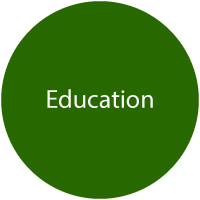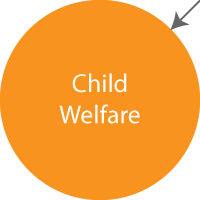Who Is the Decision Maker of the Family So Far
Description of Family Date at the Service Level
Family engagement is essential in promoting positive child and youth outcomes in didactics, mental wellness, health, child welfare, and juvenile justice. These primal child and youth serving systems are incorporating practices, policies and processes inside their agencies to strengthen and implement meaningful family engagement at the service level. Increasingly, staffs are collaborating with family members in planning and decision-making regarding their children'south and youth'south needs, services, plans, and goals. Kid and youth serving agencies are creating distinct family engagement approaches that marshal with their bureau'south mission, goals, and functioning and outcome measures. Each child serving arrangement has focused their family engagement efforts on important service areas as reflected in the following diagram:
Family Appointment Focuses on Fundamental Service Areas
 | ||||
 | ||||
 |  |  |  |  |
 |  | |||
 |  |
Didactics — Meaningful family appointment in schools means that families and educators work in partnership to back up all students in academics, social emotional learning and evolution and ultimately educational success, using enquiry-based practices and supports in schools, classrooms, and at home.ane
Child Welfare — Caseworkers engage families in individualized planning and goal setting related to safety, permanency and well-being for every immature person and family unit receiving child protective services.two Each family is to be respected and recognized every bit having expertise about their ain family and need to exist actively involved in making decisions for the young person.3
Juvenile Justice — Parents and families are actively engaged in the rehabilitation of juvenile justice-involved youth past serving in key roles as recipients, straight supports, extenders, or managers of services.4 Justice system providers are highly motivated and actively work to routinely integrate parent and family engagement inside their system.
Mental Health — A family-driven care arroyo guides youth mental health providers including child psychiatrists, on how to finer engage families in their child'south care.five Family-driven intendance means family members take a primary role in determination-making and co-designing their kid's comprehensive service plan and treatment goals, including the option of culturally and linguistically competent supports.6
Primary Health — Patient- and family-centered care is an arroyo to the planning, delivery, and evaluation of health care that calls for collaboration and partnerships among health care providers, patients, and families. In patient- and family-centered care, patients and families define their "family" and decide how they will participate in care and decision-making.7
Commonalities in Family Engagement Principles and Practices Across Service Systems
Child and youth service systems share commonalities in their family engagement principles and practices such as shared decision-making, collaboration, partnership, two-style communication, meaningful roles, mutual respect and acknowledgement of family expertise.8 These systems have articulated guiding principles that reflect the organization'due south beliefs almost why and how they volition bring about family date.
Guiding principles are most constructive when staff and families are involved in developing and regularly revisiting the philosophy that will guide how they operate. Meaningful family engagement also means that families can serve in various roles that contribute to their child'south progress and success in achieving personal goals.
Roles performed by families may include serving as a:
- collaborator in service planning,
- encourager,
- overseer of services,
- monitor,
- participant in services,
- parent peer back up provider,
- advocate,
- decision-maker,
- cultural banker,
- learner, and
- trainer of families and staff to name a few of many roles that families can perform in support of their children.
Address Staff Readiness for Family Appointment
Although the impact and benefits are articulate, implementing family engagement is not lucent. Family and staff partnership is most successful when both staff and families are prepared to communicate and interact. A lack of advice with and support for families is associated with lower levels of family engagement.ix Professional person development on family unit appointment can help prepare staff and families on how to partner and interact. However, each staff and family must piece of work at edifice trusting relationships as a foundation to appoint in difficult conversations virtually needed change.
Some agencies encourage self-assessments to gauge bureau and staff attitudes, beliefs, and readiness to piece of work with families as equal partners. Some agencies besides include family unit appointment metrics or indicators in staff/ambassador evaluation and performance systems.10 Family unit engagement becomes an essential component of whatever collective touch on strategy as human service sectors work to create a culture of shared responsibleness for improving outcomes for all youth. Engaging families in our communities requires a shared attempt with leadership, educators, providers and customs members committing to engage families in purposeful ways to assist them support their children'southward development.11
Resources
Instruction (K-12)
Mental Wellness
Family unit-Driven Care: Are We There Yet?
This resource addresses the needs of both school and mental health systems, such as mutual agreement of approach, language, theories, and perspectives. It discusses how positive beliefs supports, wraparound, and response to intervention are evidence-based frameworks that take served to unify the efforts of education staff, mental health practitioners, and families to meliorate youth outcomes. Includes an overview of evidence-based programs that include a family component.
Family unit-Driven Care in America: More Than a Good Thought
This resource recounts how the definition and principles of Family unit-Driven Care have impacted the fields of mental wellness and child psychiatry. Guided by family-driven principles, youth-serving systems are implementing policies and practices that engage families as active participants in treatment and in policy evolution and organisation reform efforts. Research shows that better outcomes are achieved when family unit members and youth have meaningful roles in their treatment as reflected by featured programs.
Child Welfare
Family unit Engagement Web-Based Practice Toolkit: Cadre Principles of Family Engagement Practices
This online toolkit includes an Organizational Cocky Study on Family Date cess forth with guidance, tools and resources for the field on how to amend family date practices across child welfare programs.
Child Welfare Information Gateway
This website presents child welfare do models to emphasize family appointment as a cornerstone of achieving positive outcomes. These practice models build from a clearly divers vision and gear up of core values and contain definitions, explanations, and expectations of how an agency will operate and partner with families.
Principal Health
A Roadmap for Patient + Family Date in Healthcare
Patient and family engagement is considered essential in improving health care, health outcomes and overall population health. The roadmap highlights opportunities to improve our healthcare system past creating meaningful partnerships with patients and families; and is intended to spark ideas and activeness from individuals and organizations interested in advancing the piece of work of patient and family engagement.
Profiles of Change
Profiles in Change is a section of the Patient and Family-centered Care website that features hospitals, clinics, and health systems that are advancing the practice of patient- and family unit-centered care in systems that specialize in children's healthcare.
Engaging Patients and Families in Their Health Care
This resource contains tools and resources for providers and patients and family members on how to amend their healthcare experience and appointment such equally tips for patients, questions to enquire of their physicians and how to prepare for medical appointments.
Juvenile Justice
Family Engagement in Juvenile Justice
This comprehensive literature review addresses the part of family appointment for youths involved in the juvenile justice organisation; cites research documenting how jurisdictions have attempted enhanced engagement, including policies that encourage family engagement. The review farther addresses resources that help families to sympathise the juvenile justice process including practices such every bit parent training, family therapy, and family visitation; and outcome testify for programs with family unit engagement strategies as key components.
Engage, Involve, Empower: Family Engagement in the Juvenile Drug Handling Courts
This brief provides recommendations for successful engagement of families in the juvenile drug treatment court procedure informed by key findings of a national survey, which measured court practices and staff perceptions related to family engagement. Also presented is essential information on substance use and addiction among young people; a self-evaluation tool to assess a courtroom's current practices; and features ii juvenile drug treatment courts that demonstrate a strong commitment to family appointment.
Juvenile Defense Attorneys and Family Engagement: Same Squad, Different Roles
This brief is intended for both juvenile defenders and the families of their young clients. It provides an caption of the roles family members and defenders play in a young person'southward example; emphasizes the importance of both sides understanding the other's office; maps out the benefits of collaboration between defense attorneys and young clients' families; and outlines the opportunities for family and attorney collaboration throughout the elapsing of a youth'due south delinquency case.
References
one U.S. Departments of Health and Man Services and Teaching, 2016
ii Child Welfare Information Gateway, 2016
3 Family Engagement Spider web-Based Practice Toolkit: Core Principles of Family Engagement Practices
4 Burke, Mulvey, Schubert, & Garbin, 2014
five American Academy of Child and Adolescent Psychiatry, 2009
6 National Federation of Families for Children's Mental Health, 2008
seven Institute for Patient and Family Centered Intendance
8 Child Welfare Information Gateway, 2017
9 Hoover-Dempsey, Walker, Sandler, Whetsel, Dark-green, Wilkins, & Closson, 2005
10 Wood, Shankland, Jordan, & Pollard, 2014
xi Westmoreland, Lopez, & Rosenberg, 2009
Source: https://youth.gov/youth-topics/service-level-engaging-families-partners-decision-making
0 Response to "Who Is the Decision Maker of the Family So Far"
Enregistrer un commentaire